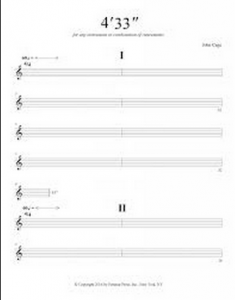Mar
2015
Four thirty-three
John Cage’s piece 4’33, although completely silent, spoke volumes. Composed to highlight the sounds of our environment, it asserted its own presence while the growing tension in the audience became palpable. In our second ‘lectorial’, we were given a chance to appreciate how the audience might have felt as we too sat in silence. The room was only silent for about 30 seconds, but as time elapsed I became hyper-aware of my surroundings. Cage described his work as a reflection on ‘Zen Buddhism’, which he studied in the late 1940s, yet it seemed to have an adverse effect upon me, for I became increasingly apprehensive as the silence continued.
I did, however, notice some themes within this space. As one individual coughed, another would, and so began a domino effect. I didn’t think much of this during the ‘lectorial’; however, on reflection I realised how innately human this was. No one wanted to break the silence, so people sat motionless, stifling any sound. Yet as one person coughed or another moved, the feeling of tension eased slightly. Once silence was restored, so too was the apprehension, causing an ebb and flow of comfort and discomfort: a very novice feeling in a world where silence is a rarity.
